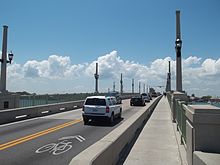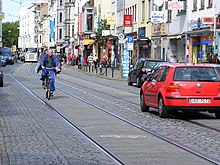Proportionately used lane



The joint lane or unshared lanes , English shared (bike) lane is an integrative form of cycling guide, which in the United States , Canada and Australia is used. An official German name is missing because this street design does not yet appear in the regulations of the German-speaking countries. Shared bike lanes are mentioned in several German sources . The city of Mainz was awarded the German Bicycle Prize in 2017 because it supports cycling on the road with (bicycle) pictogram chains in some streets .
The pictograms made up of a bicycle and arrowheads ( sharrow , for example 'Teilhabepfeil', a combination of the English words Shared and Arrow) are mostly applied in relatively close succession to the road surface in the right-hand half of the shared lane. They are intended to make motorists aware that they should expect cyclists here and then drive slowly and / or overtake considerately at a sufficient distance. Cyclists should be encouraged to drive a sufficient distance from parked cars in order to avoid accidents with suddenly opened car doors ( dooring ). If, for example, on roads with more than two lanes, cyclists should use a lane that is also used for car traffic in the middle or across the full width, the MUTCD regulations of the US Federal Highway Administration provide for a corresponding traffic sign and recommend coloring the middle 50% of the lane. The city of Chicago is considering marking a buffer strip in addition to parking bays so that cyclists really keep sufficient distance from car doors.
In Europe, this facility is officially in France and the Czech Republic. In France , the car lane marked with pictograms to guide cycle traffic is called voie partagée , differentiated from the delimited bandes cyclables conseillées (recommended cycle lanes) and bandes cyclables obligatoires (compulsory cycle lanes). In the Czech Republic , the rows of bicycle pictograms on car lanes are called piktogramový koridor , also called cyclopiktokoridor .
In addition to markings for strict separation ( cycle lanes ) and soft separation (supply or protection lanes ), the German road traffic regulations provide for the shared use of bus lanes by bicycles, as well as, in selected cases, the privilege of cycling through a cycle street , the emphasis on equal shared use not through motorized vehicles and bicycles. Nonetheless, some traffic authorities in Germany also use bicycle pictograms on the roadway to discourage cyclists from cycling unlawfully on the sidewalk or a left-hand cycle path or dangerously close to curbs or parked cars, or to encourage them to use the next to a cycle path that is not mandatory Driving lane.
The German regulations have not yet recognized any traffic areas with a status analogous to shared lanes . For the use of rows of bicycle pictograms as psychological support for cycling in mixed traffic on the roadway, some planning offices use the terms pictogram lane , pictogram lane or pictogram chain . In the research project "Cycling in Cramped Conditions - Effect of Pictograms and Signs on Driving Behavior and Road Safety", the Bergische Universität Wuppertal is investigating whether and how a. Improve cycling safety with bicycle lane pictograms (duration August 2016 to February 2020).
Web links
- ADFC Leipzig: sharrows - wheel markings for shared lanes
- Bike Cityzens: Shared lane in the center of Madrid
- Peter Gwiasda: Cycle traffic concept for the inner city of Cologne - network concept and forms of management of cycle traffic (lecture from October 20, 2014, PDF), page 34, mixed lanes (“Shared Bike-Lane”) .
swell
- ↑ BMVI AGFS: The German Bicycle Prize 2017. Accessed on February 4, 2019 .
- ↑ Thunder Bay (Ontario) : City information page: shared lanes above , bike lanes below
- ↑ US Department of Transportation, Federal Highway Administration: Manual on Uniform Traffic Control Devices (MUTCD), 2009 Edition: Chapter 9C. Markings , last bullet point
- ^ Lincoln Avenue Bikeway Improvement. Retrieved February 4, 2019 .
- ↑ County of Bentheim, Competence Center for Cycle Traffic ( Memento of the original from February 15, 2015 in the Internet Archive ) Info: The archive link was inserted automatically and has not yet been checked. Please check the original and archive link according to the instructions and then remove this notice. and VIA Cologne : The new ERA (recommendations for bicycle traffic facilities) - bicycle traffic guidance on the route and in the traffic junction (PDF) ( Memento of the original from March 31, 2016 in the Internet Archive ) Info: The archive link was inserted automatically and has not yet been checked. Please check the original and archive link according to the instructions and then remove this notice. , Slide 11 - Lane guidance
- ↑ Lecture by Dipl.-Ing. Uwe Petry, slide 15 Planning office for traffic alternative wheel (VAR), symposium Radverkehr Landkreis and Stadt Gießen, May 5, 2014, last accessed January 20, 2017.
- ↑ IVM guidelines, page 25
- ↑ ivm GmbH (ed.): Promotion of cycling and foot traffic . Frankfurt am Main 2014, p. 25 ( ivm-rheinmain.de [PDF; 4.6 MB ]).
- ↑ Bicycle traffic article by the city of Eschborn ( Memento from December 8, 2015 in the Internet Archive )
- ↑ Development of the bicycle traffic concept in the city of Monheim: Presentation slides by the Via / Cologne planning office Slide 39 ( Memento from December 8, 2015 in the Internet Archive )
- ↑ Research project [1] "Cycling in Cramped Conditions - Effect of Pictograms and Information Signs on Driving Behavior and Road Safety" www.nationaler-radverkehrsplan.de, October 31, 2016, accessed December 23, 2016.

